Asparagus Aphids are another but they tend to attack the foliage.lancashire lass wrote: ↑22 Feb 2023, 14:09 Asparagus seems to only have one major pest that I know of - the Asparagus beetle.
Not sure if they are in the UK though.

Growing your own to lower food costs - 2023Re: Now is the time to plant bare-rooted AsparagusAsparagus Aphids are another but they tend to attack the foliage. Not sure if they are in the UK though. "Not all those who wander are lost"
Asparagus AphidI don't recall aphid problem but that is not to say that it is not in the UK already but has not yet got widespread to be noticeable Brachycorynella asparagi - European asparagus aphid
Last edited by lancashire lass on 23 Feb 2023, 14:31, edited 1 time in total.
Re: Growing your own to lower food costs - 2023I have to agree it is a good looking beetle (as beetles go)! Reminds me of our Colorado Beetle, a good looker that unfortunately we go to war with every year!
"Not all those who wander are lost"
Now is the time to plant bare-rooted Strawberries (and berry canes)Strawberries sold bare-rooted (that is, not already growing in a pot) are usually delivered about now from online seed supplier pre-orders (that is, if you had purchased a number of items including seeds, seed potatoes, onion sets and so on, those not requiring attention such as seeds are normally sent out right away whereas seed potatoes and bare-rooted stuff are only sent out later)
I put berry canes in brackets in the title because they are normally available from about November and can be planted throughout winter and into spring. Strawberries are a great little investment - they will produce a great crop in the same year they are purchased, and later send out runners (baby plants) to increase your stock. A single plant will be very productive for up to 3 years by which time you should have plenty of replacements waiting to take its place. Strawberries and cane berries (raspberry) come in different fruiting seasons. When buying plants (or canes), try to stretch your growing season by having some early maturing, mid-season and autumn harvesting varieties. Perpetual strawberries are also known as everbearers - they produce fruits throughout the growing season. However, unlike the other varieties which produce heavy yields within a short period, everbearer strawberries only produce a few fruit at a time. One more reason for adding strawberries to your grow your own garden - when the strawberry is ripe and the sun is shining, pick it, smell it and then devour it. If all you have known are supermarket strawberries, then you are in for a delight. More about growing strawberries from the RHS Raspberries come as summer fruiting or as autumn fruiting varieties which require different pruning schedules. Trim back the wrong one and you may be snipping off the following season's fruit bearing tips! - Summer fruiting varieties produce fruit on one year old canes. The canes are pruned after the fruiting season ends. - Autumn fruiting varieties produce fruit on that year's growth. The old canes are normally trimmed back in February and any new canes that grow will produce fruit later that year. More about growing raspberries from the RHS
Time to start sowing - MarchMarch is normally when cool weather crops are sown, particularly the Brassicas (cabbages, cauliflower, Brussel sprouts, swede, broccoli, Romanesco (looks like a cauliflower head but the florets are pointed and although they come in a range of colours, lime green is the more usual. Grows and tastes more like broccoli), Calabrese to name a few) Some like the Calabrese produce flowers (heads) in early summer whereas most broccoli flower the following spring but all of them are sown in early spring regardless of when they are cropped. So that winter cabbage you'll be harvesting in January next year is sown at the same time as the pointed summer cabbage you'll be tucking into at the end of June this year. The name "winter" is when things are harvested and not when they are grown. Short growing crops (for example, turnips and radish) can be sown successional, that is, a few seeds one week, a few more seeds a couple of weeks later and so on, so that you can stretch your harvesting for longer.
Nearly all Brassicas can germinate at about 5-7oC although they would do better at 10oC. The trick is to put them somewhere bright but cool soon after germination (preferably under cover outdoors) - if the indoor temperature goes too warm, they have a bad habit of trying to grow faster than they should and end up turning out limp and leggy. The good news is that a moderately "leggy" seedling is rescuable - all Brassicas do better when planted deeper than their original soil level. Another crop to start thinking about are tomatoes. If you haven't already sown your tomato seeds, then now is about right. Seeds rarely take more than a few days to germinate and then the fun begins. You don't want the seedlings to get too cold (they turn blue ... yep, they really do especially along the stem) but you don't want them to get warm (the heat encourages growth but what they really need is good strong sunlight. Poor light encourages the plants to grow tall and leggy. And like the Brassicas, the good news is that tomato seedlings can be planted deeper than their original soil level.
More seeds to sow in MarchBrassicas are really quite hardy and when temperatures drop below optimum, they will recover without too much problem. Other seedlings on the other hand are not so hardy and for the sake of a few short weeks when the spring weather is much more obvious, they are likely to do much better then than trying to start them off now.
You could start seeds off indoors and place them in a cool room or under cover outside (be aware that if it is too cold, seeds take longer to germinate than when the weather is warmer) And of course, those areas enjoying blizzards probably could wait a bit longer than those basking in a mini heatwave: I personally (in the midlands of the UK) would wait until the end of March / early April rather than sow the suggested seeds above now. Sowing outdoors too early doesn't necessarily mean earlier cropping - when the temperatures drop, growth slows down. And always keep a watching eye on the weather forecast - it may be mild today but in a few days when seedlings should be appearing, the temperature may have dropped (oh the joys of UK weather) Meanwhile, start getting those sowing beds ready and weed free, soil is raked to a fine tilthe!
Pepper & Chilli sowing to be done now!If you haven't already sown your pepper and chilli seeds, you should aim to do that now rather than later. They need very warm temperatures to germinate (between 20 and 25 oC) - if the temperature is lower, they take much longer to germinate. This is a good time to try chitting the seeds (place the seeds between sheets of damp paper towel either inside a zip lock bag or in a lunch box and placing them somewhere warm. After a couple of days, keep an eye out for germination and at the first sign of the root appearing, gently transfer to pots of compost to continue on. Keep the pots warm so that the germination process is not interrupted)
When the seedling leaves appear, move the pots to a sunny windowsill but again, try to keep the pot warm (windowsills in winter can be chilly so you may want to put a table close to the window so the plants benefit from the warmth of the room) At night, move the pots into the room before closing the curtains.
A couple of unusual but high yielding crops to growWhen you have a large allotment plot, it is easy to experiment with some unusual crops you would never normally see in the supermarket. The most likely reason you rarely see them despite their ease of growth is that they either look too unusual for most shoppers to try, don't store well or bruise readily during transit but for the home gardener, they might be worth a little space in the veg garden.
I've included these 2 as tried and tested varieties I've grown myself. The yield is very high and in my opinion worth growing: The Achocha (Cyclanthera pedata) is a relative of the cucumber family from South America and grows very well outdoors in the UK garden. The plants are vine-like and will scramble up canes and netting. They really are the triffids in the garden once they start growing in earnest. In the photo below, they are behind the rhubarb:  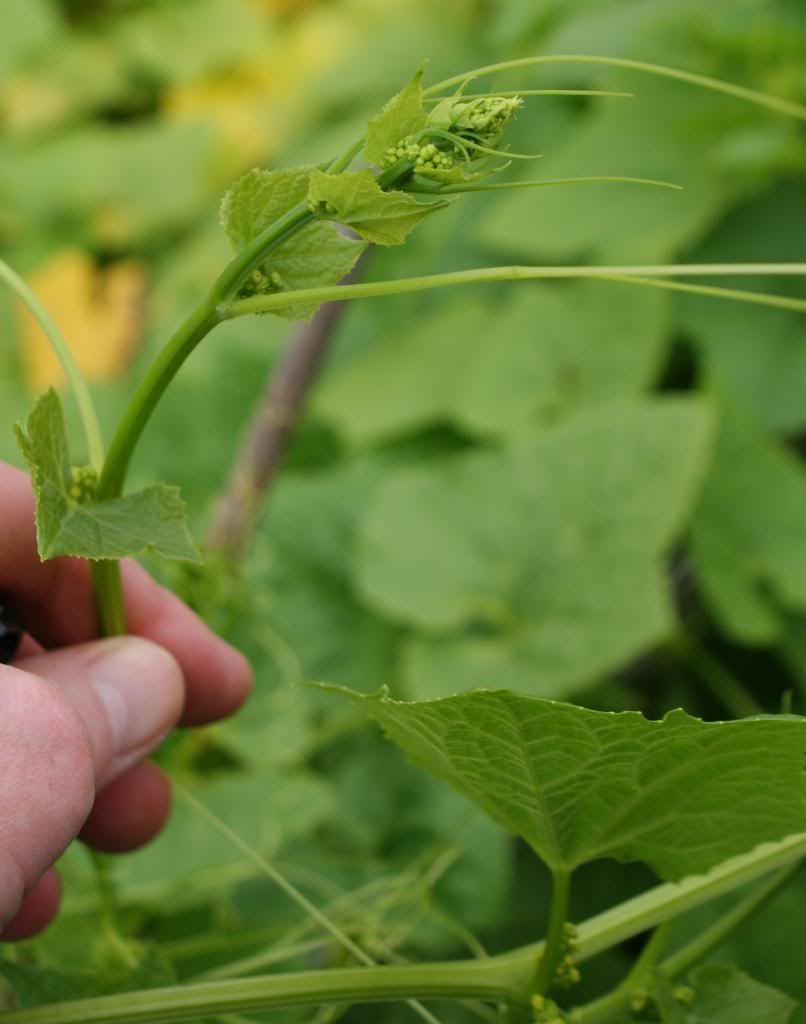 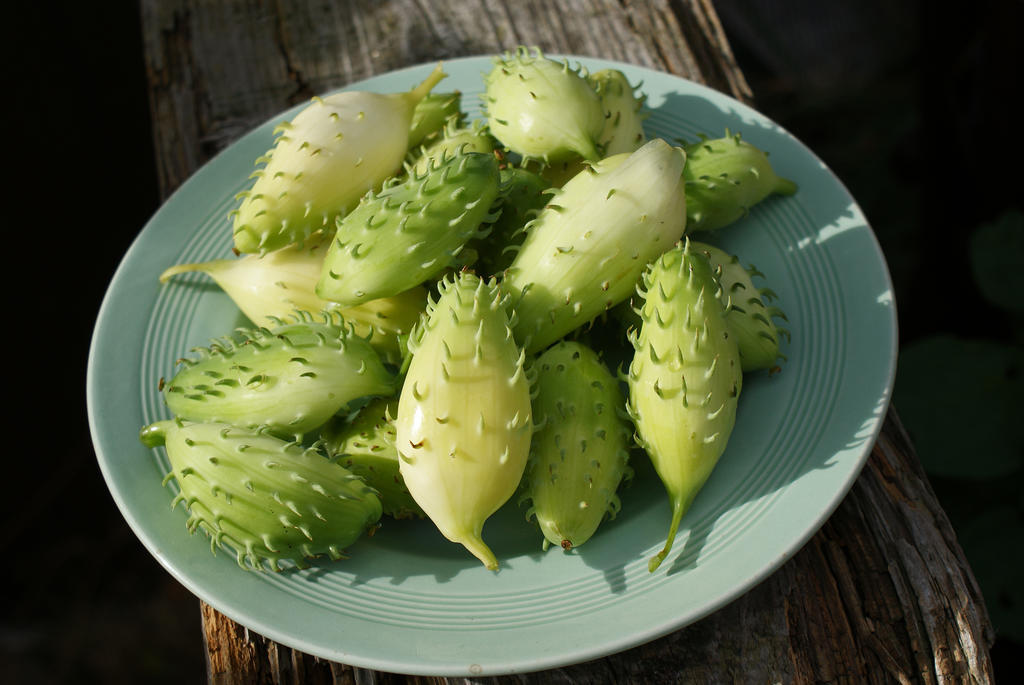 The "spines" are fleshy and soft and do not need to be taken off when preparing them in the kitchen. From the Real Seeds Catalogue, they describe this variety called Fat Baby: and an article from The Guardian The Real Seeds Catalogue are one of the few online seed suppliers that sell some other unusual crops if interested, but I cannot vouch for how they turn out (growing, cropping, cooking, flavour) However, I can vouch for growing Quinoa (Chenopodium quinoa) as in their grains section. I grew the Rainbow Quinoa variety and the yield was huge. If you buy Quinoa from the supermarket, you'll notice it is ridiculously priced for what you get so growing your own may be worth it. The only downside is that they do require a cleaning process after harvesting to remove the saponins on the seeds (it is like a soapy layer which protects the seeds from being eaten) - I spent a lot of time soaking, draining, rinsing the seeds in several buckets of water and sieving off. In the photos below, I hung the seed heads under the awning over my (south facing) back door to dry off after harvesting. Each cluster contains several seeds which are released when it is gently rubbed between fingers. The action of saponin in water is what you would expect - lots of frothy bubbles ... it takes several rinses (you'll need a sieve or some fine net to stop seed from going down the drain) and once the frothiness has gone, spread the seed on paper towelling and air dry thoroughly before storing (otherwise they'll go mouldy during storage): 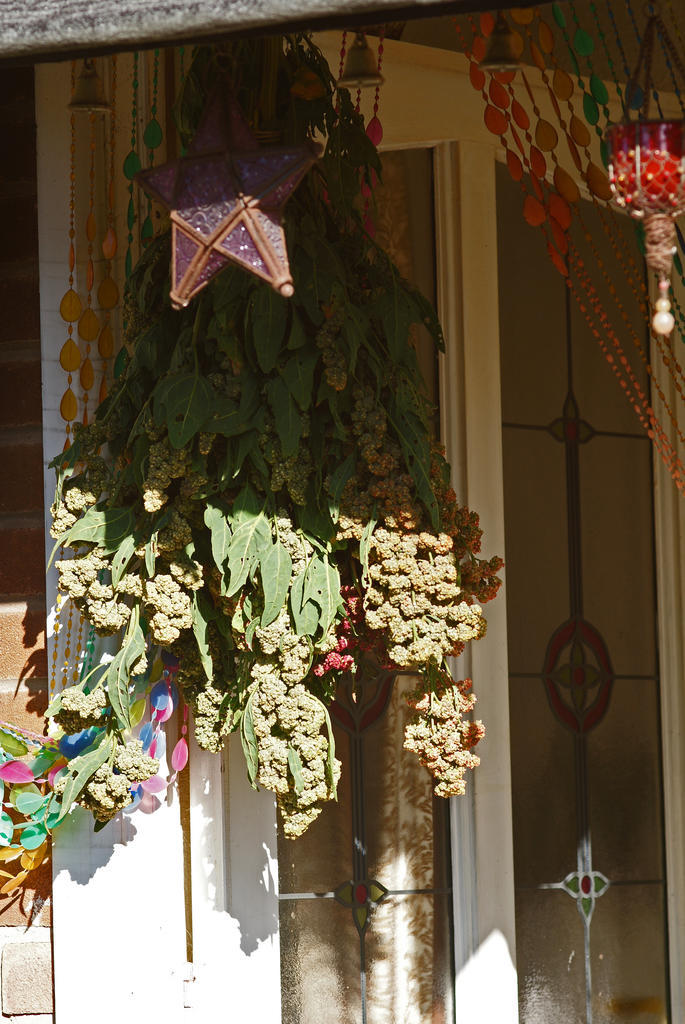 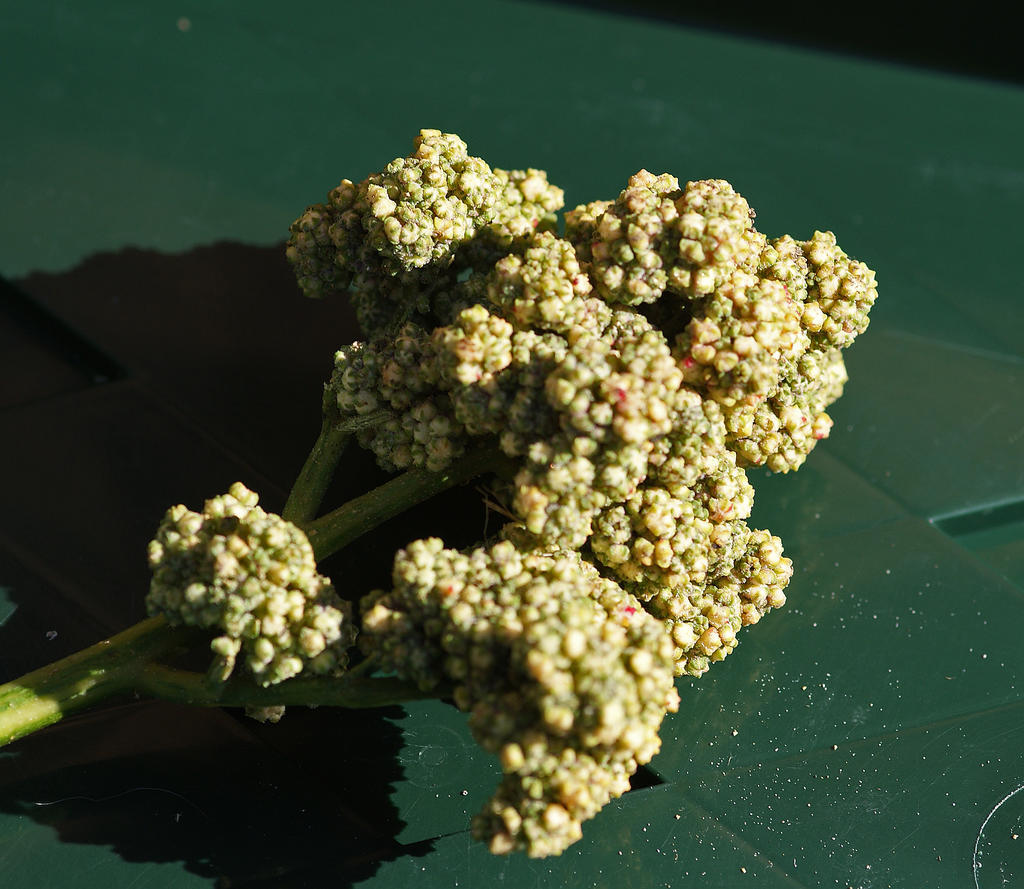 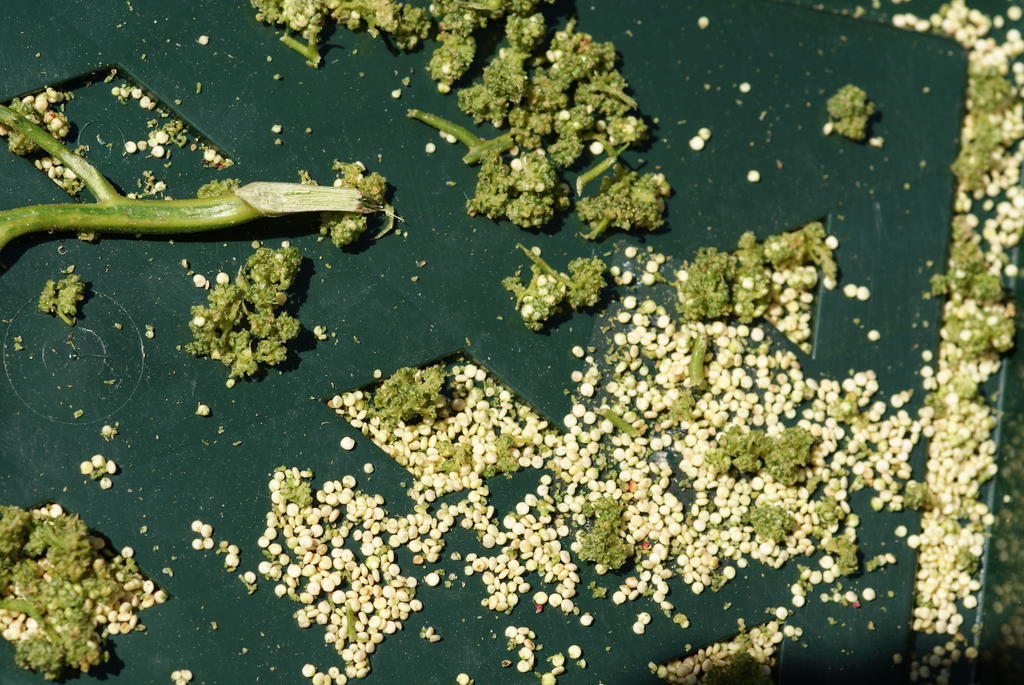 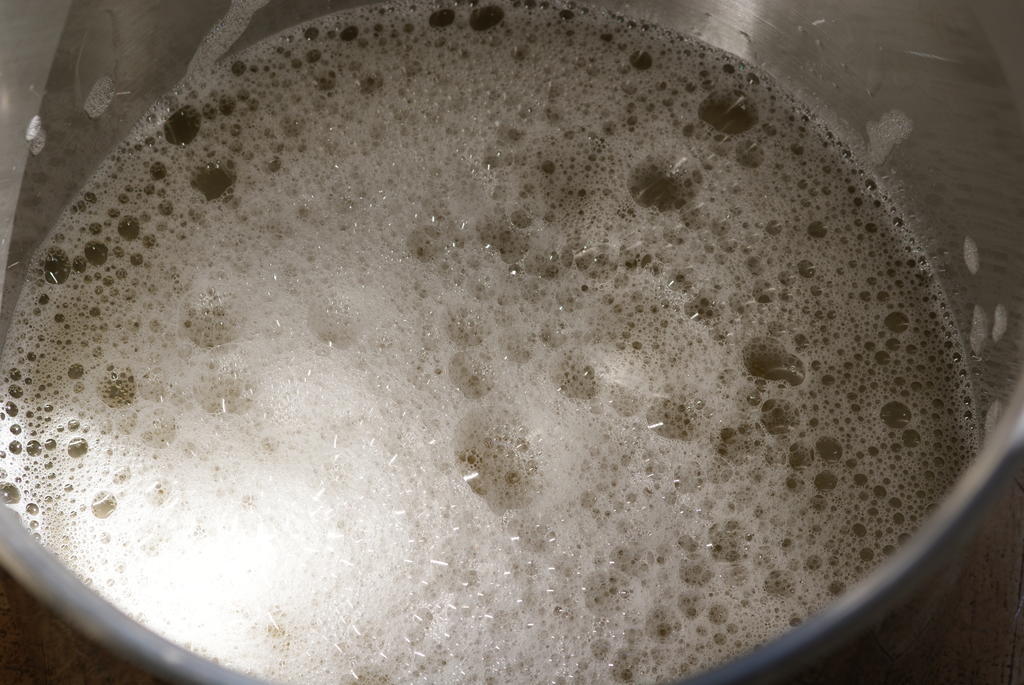 I'm going to try and give these a go again myself this year but this time will be growing a few seed from supermarket purchased grain (in the dried pulses and grains section) I should warn that the plants look remarkably like a common garden weed to which they are related known as Fat Hen (scientific name Chenopodium album) The cultivated crop grows about 4 feet tall and when the seed heads are developing, it is worth supporting the plants by tying them to canes.
Lettuce - so many to choose from ....There are an insane number of lettuce seed varieties for sale and if unfamiliar with growing your own, most people might go for the familiar ones they see in the supermarket. However, rather than go for the big headed lettuce such as Iceberg (which I never really found as crispy as those sold in shops), aim for the smaller headed varieties such as Little Gem or soft leafed butterhead varieties which are easier to grow and mature earlier so ideal for successional sowings (a few seeds sown every other week) for salads throughout summer and into autumn, or the "cut and come" again varieties (such as Lollo or Lollo Rosso) where you nip off the outer leaves (ideal for slipping in the lunchbox sandwich) and let the plants keep on growing. The cut and come again varieties also grow well in containers so if you are short of space, I would recommend these.
A word of warning - NEVER let the roots of any lettuce variety get dry so especially keep them well watered during heatwaves. Even if you "rescue" the plants and drench the soil with water, the damage is done. The plants go straight into seed production and the leaves thereafter taste bitter. Lettuce can be grown in partial shade (that is, some sun and some shade during the day)
Carrots - which ones are best?You can buy seed for carrots in different colours, length, sweetness and either for summer use or late autumn/winter use (storage) and knowing which variety to choose can seem a minefield.
For a reminder about pests, the link will take you to the post about The Carrot Fly and how to try and avoid the damage done. You could try growing a Carrot fly resistant variety called Flyaway F1 (but the resistance is not total - so still put measures in place as you would normally) And slugs and snails love the tender leaves of seedlings but once they become mature, the plants are rarely attacked thereafter. And don't forget the soil should be fertile (use a general fertilizer such as Growmore or an organic version such as Fish and bonemeal) but not soil that has had manure added. Another thing you need to consider is your soil type. Sandy soil is the best for growing carrots. Clay is do-able but you really need to dig in lots of compost / sand and make sure the root will have no obstacle (like compacted clay clod) - the easiest way to do this is dig a narrow trench where the row will be sited, and fill with compost and then use some of the clay soil on top (helps to trap the moisture in the soil) but make sure it is broken up (like using your fingers for a fine tilth effect) Stony soil makes poor soil for the traditional carrot but this is where you have options to choose from. Luckily there are different shapes of carrots which suit heavy clay in particular - short stumpy varieties grow about 3 or 4 inches, some like the Chantennay type have a pointed end and wide shoulders. Early Market and Burpees Short n Sweet have even shorter root, and Paris Market are the shortest of all with almost a ball shaped carrot (ideal as lunch box fillers or popped whole into soups and stews) which can be grown in stony soil. Carrots can be grown successfully in containers of compost - the deeper the pot, they are ideal for the long carrots so the range available is wide. Unlike the traditional row of a vegetable plot, thinly sow the seeds over the entire surface of the compost and lightly sprinkle compost over the top. Sow successional (a few seeds every other week) to enjoy fresh carrots all through summer into autumn. You can of course freeze surplus to use as and when needed in cooking. For winter vegetables, you should go for an autumn cropping variety (they store well over winter or in mild areas can be left in the ground and lifted when needed) such as Autumn King If you want to try different colours (white, purple, yellow), google search "Rainbow Mix" ... they still taste like carrots but make an interesting change to the classic orange ones. In this link, the pack contains Rainbow, Red Samurai (a Japanese variety which is long and slender) and Purple Haze. Some carrots are naturally high in sugars and beta-carotene so something like Sugarsnax F1 might go well with children or as lunch box fillers. One more thing - always sow carrot seeds direct where you intend to grow them. They really don't like their roots disturbed and the end result can be root shapes that are far from ideal for kitchen use (multiple roots twisted that are difficult to clean and peel) Watering - once carrot roots have penetrated deeper soil levels, they just need a drenching as and when required. The key is drenching not watering (the water should be puddling on the top and allowed to drain - you can test how deep it is by pushing your finger into the soil) If you only lightly water, the root has no need to grow deep and will take water up that is near the soil surface.
Books, tv + websitesIf you have been reading the posts in this thread so far, it may seem like growing your own is a lot more complicated than you realised. Hopefully there has been some inspiration amongst the pitfalls that you may come across but my message is to give growing your own a go, even if it is just one or two crops in a container. The problems I've highlighted came with experience over the years - just because I mentioned this pest or that disaster, remember these are accumulated memories! My first attempt at growing my own were a few pumpkin seeds into a Gro bag and yes, it wasn't all plain sailing (too many plants in one bag didn't help) but what I remember most is harvesting my very own home grown pumpkins. When I moved to my current house, I grew sweetcorn for the first time in the garden (of course I planted them in a single row rather than as the recommended block formation so pollination could have been a problem, but hey - luckily it worked out fine and they were the bestest, sweetest sweetcorn cobs I'd ever tasted in my life)
I am one of those people who like to know more (can I do it better some other way, what fertilizer should I use, how can I increase yields) so I decided to read a few books and look things online. One thing I can recommend is the BBC Gardener's World - the new tv gardening season starts about now (BBC 2 at 8 pm) which is great for beginners as the new beds are prepared and seeds are sown. But even some of the period series like the Victorian farm or Wartime Farm can be interesting with some old fashioned ideas which have been lost today. For those who like to finger a book, I think the bible of vegetable gardening has to be Grow your own vegetables by Joy Larkcom. I think there is an up to date version now but it has been around for decades. My first book was The Vegetable Expert by D. G. Hessayon. I thought it was the best book but over time, I was less in favour of the pesticides and fertilizer regime as attitudes to gardening changed. There may be a revised version out. Of course there is our own John Harrison and his book The complete Vegetable Grower and his other books on different topics (month by month, container growing, storing your own produce) Maybe some of our more experienced gardeners can share what their fave books are? As for websites, there are so many to choose from. Personally if I am on a mission (for example, I want to know about something specific - for example, how to grow rhubarb) then I do a google search. The RHS gardening website has much to offer and then there's Gardener's World to name a couple. Visit some of the online seed suppliers and often they have a section outside of the catalogue about how to grow crops (after all, they want you to succeed and buy from them again) Even someone's blog can offer insight and inspiration - don't forget DTL's own Vegetable Garden posts. Setting up a diary on a gardening forum (DTL has a section just for gardening diaries which you can post in) can help too - reading what others do and posting about your gardening attempts is one way to be more involved and share your plans, triumphs as well as your gardening issues.
Now is the time to plant RhubarbActually, rhubarb is quite a hardy plant but it is best to plant dormant crowns in February / March. When looking at bare rooted crowns, look out for the leaf buds (they should still be a tight ball shape and the leaf not opened) Many shops (such as Wilkos) often have displays of the seed potatoes, onion sets and bare rooted crops on shelves in the shop. Unfortunately, the warmth (and lack of direct sunlight) of shop floors can encourage the tubers / bulbs to throw out their leaves or shoots. Sometimes they are rescuable but it's always better to aim for something that is still dormant.
Rhubarb need very fertile soil - they are a leaf crop (well of course, you harvest the stem but all the food is manufactured in the leaves that get stored in the crown for next year's crop) so if possible, dig in lots of manure in the planting hole (or organic fertilizer like Fish & bonemeal) before planting the crown. The leaf buds should ideally be just under the soil surface (but not too deep) The soil should be well draining (if the crown sits in heavy wet soil, it is likely to rot) If you are lucky to get hold of a freshly split rhubarb crown from a friend or gardening colleague, it will be raring to go. Forego harvesting stalks in the first year unless it really is a well-established crown, and even then, only one or two "taster" stalks. Let the plant establish itself and in the following spring you can start harvesting. Avoid stripping off too many stalks - it needs leaves to grow and store sugars in the root / crown so if you remove too many stalks, it will quickly exhaust the crown food stores as it tries to grow replacement leaves and will weaken the plant. Rhubarb plants can grow quite big (easily 3-4 feet diameter) so allow space between plants. I successfully grew rhubarb in a big pot (with such big leaves, it needed regular heavy watering in summer) but if I was honest, the rhubarb did better when it was planted in the ground. Re: Growing your own to lower food costs - 2023Books. I liked the RHS paperbacks 'The Vegetable Garden Display' and 'The Fruit Garden Displayed' Veg was first published in 1941 (dig for victory?) Fruit in 1951 my copies are the mid 70s revision though there is a 1998 edition of Veg (with online asking prices up to £300+!) Mine have lots of black and white photos showing how to do things. Maybe more pictures than text . A section for each crop.
We bought a hardback when we started out, Ward Lock's Complete Gardening by CE Pearson. It had a lot of information but when we looked with a specific question it seemed to tell you everything except that. Over the year we collected an assortment of 2nd hand gardening books, which I must get round to taking to a charity shop. When we started Gardeners Question Time Radio 4 at Sunday lunch time was our must hear. Dance caller. http://mo-dance-caller.blogspot.co.uk/p/what-i-do.html
Sunny Clucker enjoyed Folk music and song in mid-Cheshire Re: Growing your own to lower food costs - 2023Books I learnt from:
RHS Pruning and Training: What, When, and How to Prune by Christopher Briknell & David Joyce RHS Propagating Plants: How to Create New Plants For Free by Alan Toogood by Alan Toogood (Author) The New Self-Sufficient Gardener: The complete illustrated guide to planning, growing, storing and preserving your own garden produce by John Seymour And a multitude of internet channels though often they give conflicting advice! However, I will add, I still managed to plant all the rhubarb we brought from our old house to here upside down! A fact my lovely young lady keeps reminding me of! "Not all those who wander are lost"
|
Down the Lane Regular entries focusing on Nature in the Garden and beyond
Regular entries focusing on Nature in the Garden and beyond
Click here to go there
Poultry Supplies •Chicken Fencing •Drink & Food Feeders •Health & Wellbeing •Red Mite Products •Poultry Feed •Automatic Door Openers •Chicken Keeping Books
Chicken Breeders Over 400 Breeders across the UK now listed.. Chicken Breeders & Other Poultry UK Pages
Ex-Battery Hen |
